🧤 Weed Management
Concept, Methods, Cultural, Mechanical, Chemical, Biological and much more.
Weed Management
Weed management is the application of certain principles and suitable methods that will improve the vigor and uniform stand of the crop. At the same time ignore or discourage the invasion and growth of weeds.
👉🏻 Methods of Weeds Management
Weed control and weed management are the two terms used in weed science. Weed control is the process of limiting infestation of the weed plant so that crops can be grown profitably, whereas weed management includes prevention, eradication and control by regulated use, restricting invasion, suppression of growth, prevention of seed production and complete destruction. Thus weed control is one of the aspects of weed management.
👉🏻 Principles of Weed Management are 1. Prevention 2. Eradication 3. Control
(A) Preventive Method
It encompasses all measures taken to prevent the introduction and/or establishment and spread of weeds. Such areas may be local, regional or national in size. No weed control programme is successful if adequate preventive measures are not taken to reduce weed infestation. It is a long term planning so that the weeds could be controlled or managed more effectively and economically than is possible where these are allowed to disperse freely.
👉🏻 Has two dimensions
- Time: To prevent the infestation prior to weed germination.
- Space: To prevent the introduction or spread to new areas.
👉🏻 Preventive method has following measures (a) Crop management practices are:
- Use of vigorous and fast growing varieties.
- Proper placement of fertilizer.
- Better irrigation practices.
- Proper crop rotation.
- Higher plant population.
- Effective prevention of weed seed production both in cropped and non-cropped area.
(b) Use of weed free crop seeds:
- Separating crop seeds by separators.
- Clearing and testing.
- Employing clean agricultural equipment.
- Using well decomposed weed free FYM and compost.
- Adopting measures to prevent carrying of weed seeds and propagules.
(c) Seed certification
(d) Weed Laws: There is no weed law in India except Karnataka which declared Parthenium hysterophorus as a noxious weed.
(B) Curative/Remedial Method
(B1) Eradication Methods:
- Destroying the spp. at the initial stage of introduction and before it produces any propagules or enforces its regenerative capacity i.e. at an early growth stage.
- Degenerating the buried dormant but viable seeds by fumigation, flooding, heating & other methods.
(B2) Control Methods
- Physical and Mechanical Methods
- Cultural Methods
- Biological Methods
- Chemical Methods
(a) Physical and Mechanical Methods**
-
Hand Weeding: Two to four hand weeding for most of the field crops. The interval between two hand weeding is 15-20 days.
-
Hand Hoeing: The hand hoe first animal drawn implement invented by Jethro Tull in 1731.
-
Spudding: Hand weeding, hand hoeing added by a sharp-edged sickle.

-
Dredging: With the help of mechanical force to remove aquatic weeds along with their roots and rhizome.

-
Chaining: Floating aquatic weeds are removed by chaining. Other physical methods are - Hand hoeing, Digging, Spudding, Tillage, Mowing, Mulching, Flooding, Clipping, Burning, Chilling.

-
Sickling
-
Digging
-
Mowing
-
Cutting
-
Burning
-
Flaming: It is the momentary exposure of green weeds to as high as 1000 °C from flame throwers to control in row weeds. Dodder is also controlled by flaming in lucern.
-
Searing: Repeated application of flame to above ground parts destroyed the root system and plant dies.
-
Soil Solarization: It is also called solar soil heating. It is effective against weeds which are produced from seeds. It doesn’t involve any tillage of the field. Covering the soil with transparent, very thin plastic sheets of 20-25 mm polyethylene (PE) film during hottest part of summer months for 2-4 weeks.
-
Cheeling
-
Tillage
-
Mulching: Principle is exclusion of sunlight from environment. Polythene Sheets, natural materials like paddy husk, ground nut shells, saw dust etc. are used as mulching material.
-
Flooding: Flood kills weeds by excluding oxygen from their environment. Flooding is a worldwide crop husbandry method of controlling weeds in rice fields.
(b) Cultural Methods/ Crop Husbandry Practices
- Principle behind this is giving competitive advantage to the crop. Cultural methods, alone cannot control weeds, but help in reducing weed population. They should, therefore, be used in combination with other methods.
- Proper crop stand and early seedling vigor.
- Selective crop simulation: Can be achieved by application of soil amendments like gypsum/lime/manures/fertilizers etc.
- Proper planting method
- Planting time
- Crop rotation: Crop rotation is effective in controlling of crop associated and crop bound weeds. The obnoxious weeds like Cyperus rotundus can be controlled effectively by including low land rice in crop rotation.
- Stale Seedbed: “A stale seedbed is one where initial one-two flushes of weeds are destroyed before planting of a crop”. This is achieved by soaking a well prepared field with either irrigation or rain and allows the weed seeds to germinate. At this stage, a shallow tillage or a non-residual herbicide like paraquat or glyphosate may be used to control the dense flushes of young weed seedlings. This may be followed immediately by sowing a desire crop.
- Smother crops/Competitive crop: Competitive crop smother the ground quickly than non-competitive crop. Eg; Cowpea, lucern, berseem, millets.
- Minimum tillage: Zero tillage completely avoids burying of weed seeds and reduces persistence of annual weeds but it induces vigorous growth of perennial weeds.
- Summer fallowing
- Lowering area under bunds
- Flooding and drainage
Biological Method
- Utilization of natural living organism, such as insects, herbivorous fish, other animals, disease organisms and competitive plants to limit their growth.
- In biological control method, it is not possible to eradicate weeds but weed population can be reduced.
- This method is not useful to control all types of weeds. Introduced weeds are best targets for biological control.
- The control Opuntia spp (prickly pear) in Australia and lantana in Hawai with certain insect bioagents are two spectacular examples of early period biological control of weeds.
- Bio control started in the year 1900. There are 2 approaches in biological control.
Classical Biological Control
- Main objective of classical biological weed control is
restoring balancebetween target alien weed and its natural enemies in the ecosystem by introduction of suitable, exotic bioagent. - Successful bio-agent reduce the weed population first then the Bio-agent population due to starvation of food. After some time the bio-agent population may recover. This process continues in cyclic fashion till the bio-agent and weed population gets established at a low level. This method is a slow operating and currently used in non-cropped areas.
- In crop fields, the bio-agent will not get opportunity to work on host weed due to frequent use of insecticides and fungicides in modern agriculture.
- Otherwise Cyperus rotundus can be controlled in crop fields with moth “Bactra verutana” and selective bio control of Ludwigia parviflora (water purslane) by Haltica cyanea (steel blue beetle) in rice fields.
Criteria/Characteristics of successful bio-agent
- Host-specific: Bio-agents should be host specific and they should not attack other economic plant spp. They should pass starvation test i.e. they prefer to starve to death rather feed upon other than host weeds.
- Bioagent hardiness: Bio-agent should free from its own parasites and predators.
- Feeding habit: Bio-agents are more efficient in controlling weeds if they attack either flowers or seeds of the weed or bore into the stems than root and leaf feeders. But root-feeding insects are more effective in controlling perennial weeds.
- Ease of multiplication
Kinds of Classical Bio-agents
Insects
These are largely host specific i.e. one insect spp is employed to destroy the only one weed sp. First successful example reported from Hawai in 1902 Lantana camara controlled by Moth Crocidosema lantana. Insects that were found effective belong to Lepidoptera, Hemiptera, Coleoptera, Diptera.
Carp Fish
Certain fresh water Carp fish consume large quantities of aquatic weeds. Whiteamur (Chines grass carp) Ctenopharyngodon idella is promising spp for aquatic weed control. This can grow more than its body weight i.e. 5kg / year and attaining up to 50kg at its full size. Herbivorous fish are not food specific. Whereas the common carp (Cyprinus carpio) a non-herbivorous fish used to control submerged aquatic weeds.
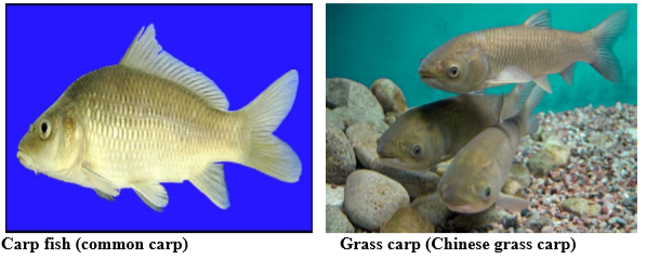
Plant Pathogen
Many fungi attack specific weed spp. For instance Acacia glauca controlled by spore suspension of Cephalosporium zonatum. Skeleton weed (Chondrilla juncia) controlled by rust causing fungi Puccinia chondrillana.
Competitive Plants
Certain plants sp. are very competitive in suppressing specific weeds. Slender spike rush (Eleocharis acicularis) aquatic plant can cover the canal bottom and it is not allowing to establish destructive tall weeds. Typha sp. can be controlled by Panicum purpurascens or Brachiaria mutica (Para grass). Marigold has potential to displacing Parthenium spp. Cassia sericea also suppressed the Parthenium.

Snails
The large tropical fresh water snail Marisa cornuarietis feed on aquatic weeds. Marisa feed on roots of water hyacinth, water lettuce and leaves of Salvinia.
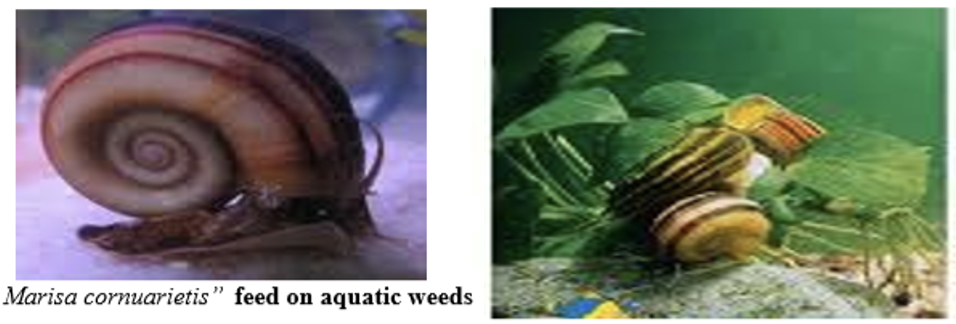
Mites
The mite Tetranychus desertorum controls prickly pear Opuntia dellini.
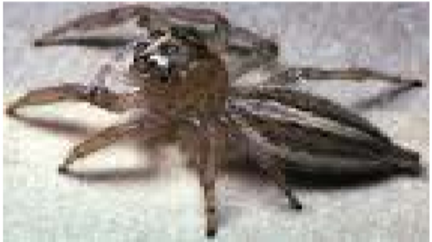
Outstanding Example of Classical Bio-Control
Lantana camara
-
Lantana was the
first weed controlledsuccessfully with certain insect bioagents in Hawaii. Of theseCrocidosema lantana, amothwas found to be promising in destroying flowers and seeds of lantana. In Australia, three successful insect biocontrol agents are hispine beetles (Octotoma scabripennis and Uroplata girardi) and tingid /lantana bug (Teleonemia scrupulosa).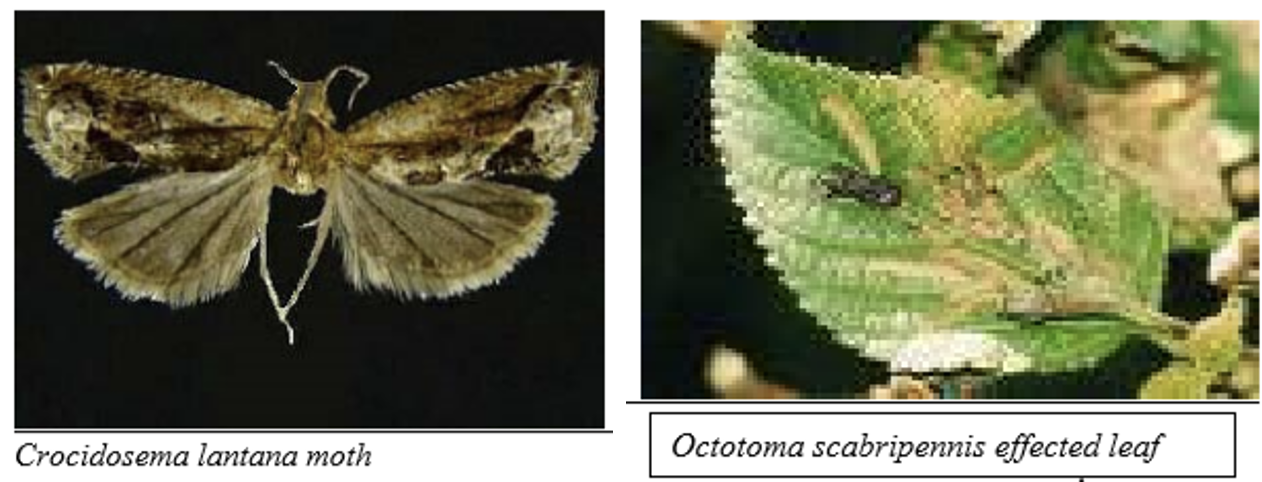
-
In Andhra Pradesh lantana has been controlled by some of these insects, besides the lantana seedfly (
Ophiomyia lantanae).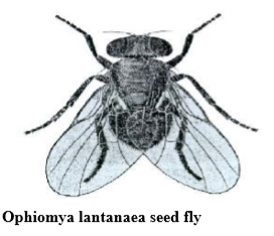
Prickly pear (Opuntia spp.)
- In Austrlia biocontrol of “Opuntia inermis” with a moth
Cactoblastis cactorum. - In Tamilnadu and Maharashtra 40,000 ha land was recovered from the weed Opuntia delini by releasing
Dactyloplius tomentosusa Cochineal scale insect.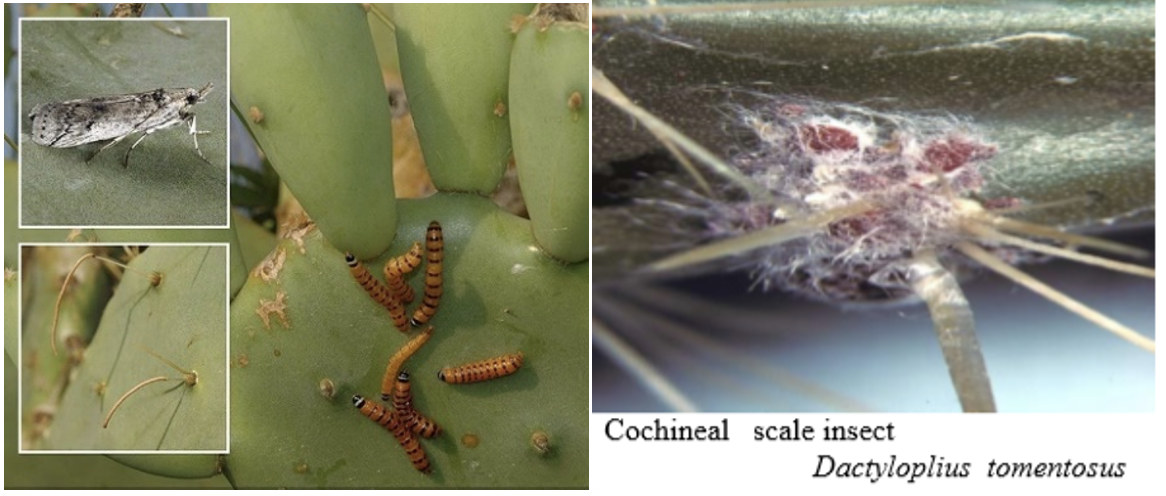
Cyperus rotundus
Bactra varutana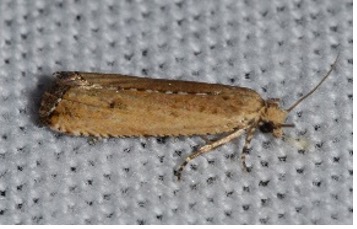
Alligator weed
- Alternanthera philoxeroides
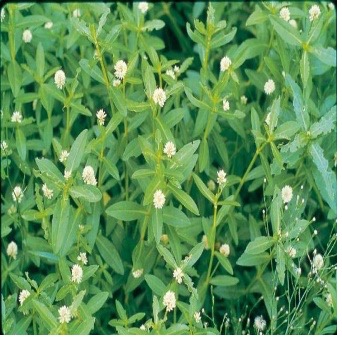
- Controlled by flee beetle:
Agasicles hygrophylaand alligator weed thrips: Anynothrips andersoni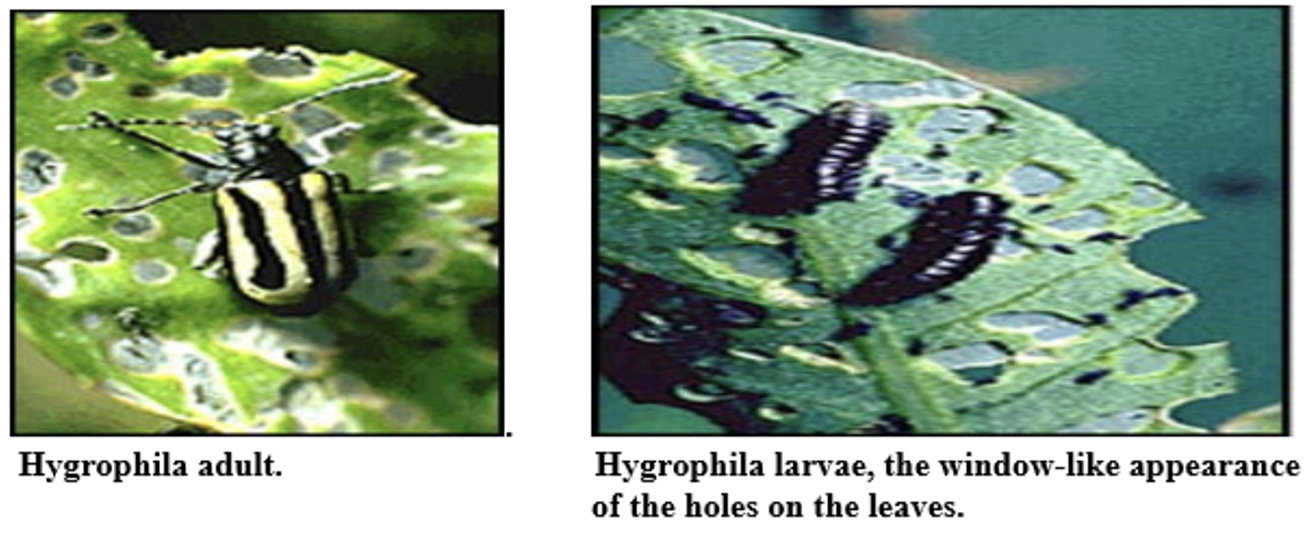
Water hyacinth
-
Eichornia crassipes
-
Hyacinth moth
Sameodes albiguttalisfeed up on young leaves and apical buds.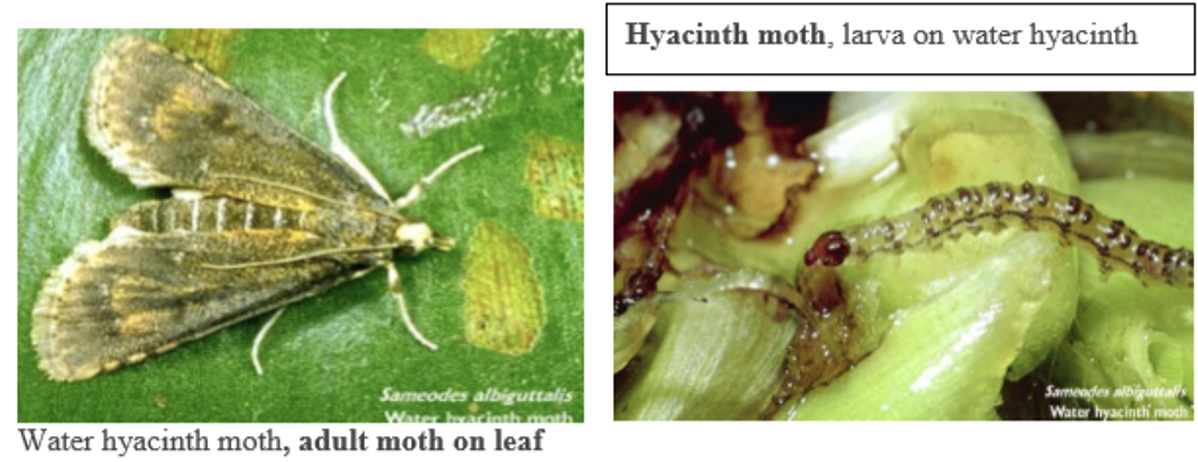
-
Neochetina bruchiiandN. eichorniae
Salvinia
Salvinia molesta- In Kerala (India) curculionid beetle
Cytrobagous salviniaeused to clear the fresh water courses and paddy fields. They feed on terminal buds and rhizomes and petioles of salvinia.
Parthenium hysteroforus
Zygrogramma bicolarata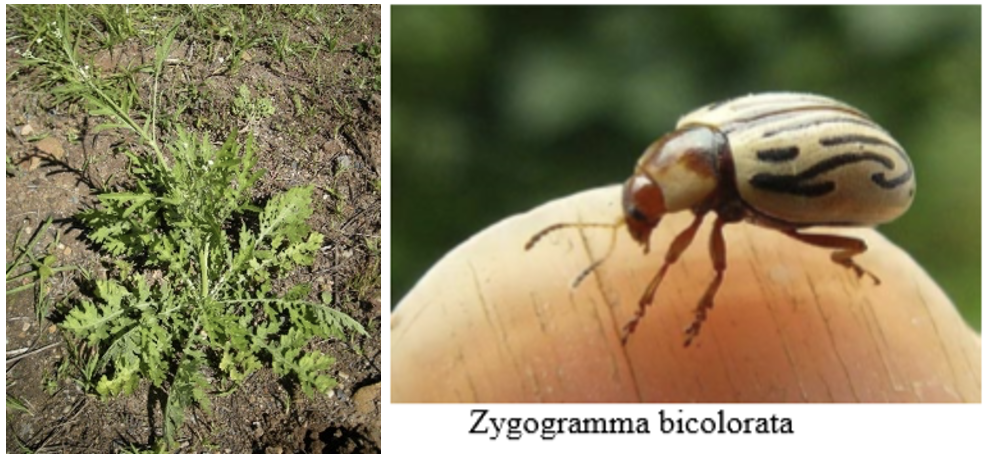
Bio-Herbicides
- Bioherbicides are pathogens cultured artificially and made available in sprayable formulations; just like a chemical herbicide. The pathogen selected for the purpose is usually from the native place of the weed, but it could also be from other places.
- The bioherbicides are also sometimes called
mycoherbicides. - A mycoherbicides can be both
specificandnon-specific. - The bioherbicide philosophy differs from the classical biocontrol philosophy referred to earlier, in certain ways as follows:
- Bio herbicide remains active only on the current weed population, without any chance of cyclic perpetuation of the weed (or of the bio agent); each new flush of the weed thus requiring retreatment with it.
- Bio herbicide can be developed for selective control of weeds in a crop just like any other selective herbicide, which is not the case with the classical philosophy bio agents.
- The development of bio herbicides is of great interest to industrialists since it involves every season requirement of the product for field use. In variance with it, the classical biological control approach has no incentive to the private, profit-oriented organizations; it must depend solely upon public sector support.
Devineis 1st commercial bio-herbicide/mycoherbicide.
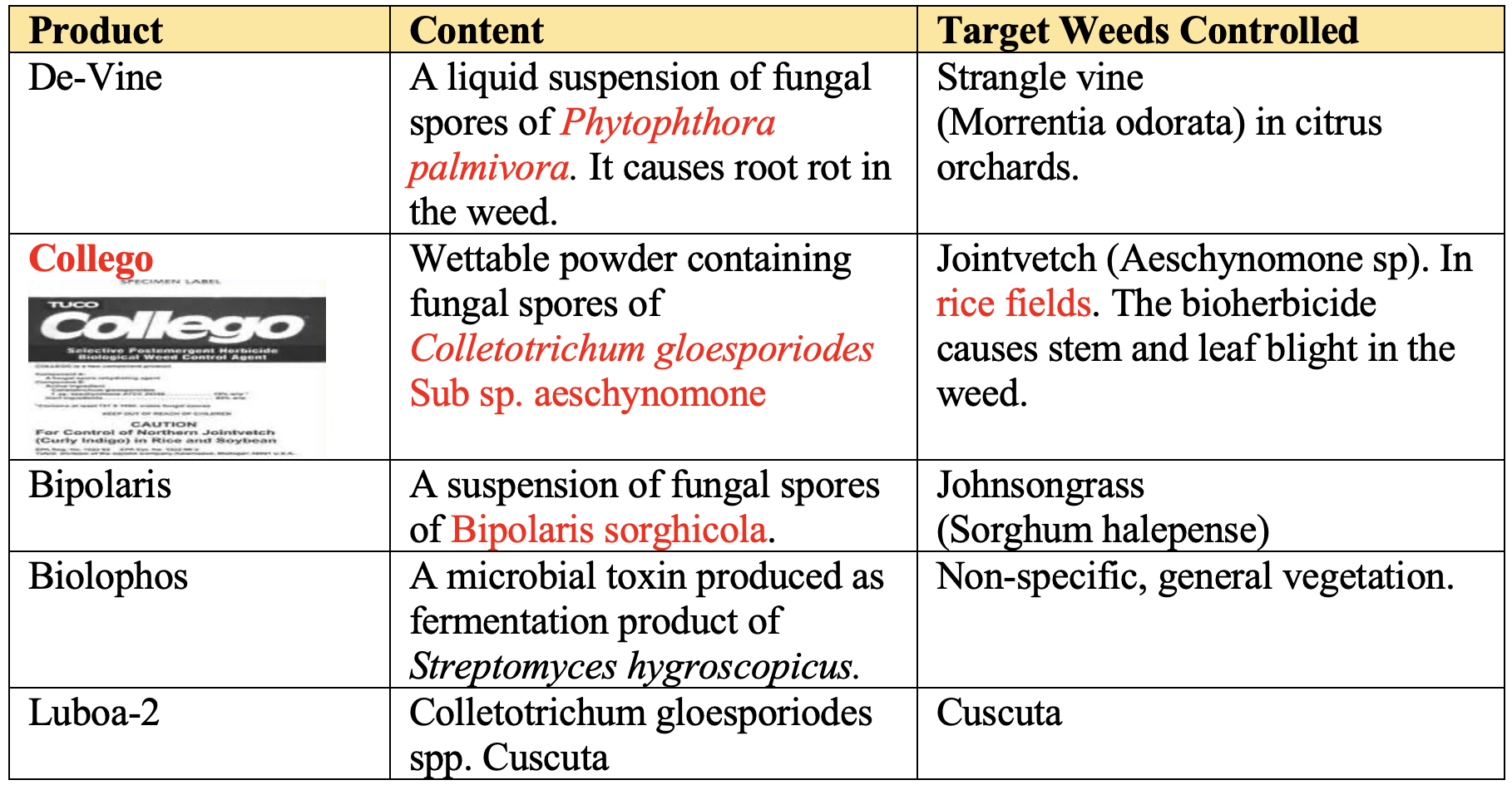
❌ Limitations of Biological control
- The weed must be highly specialized.
- It must, in its native habitat be subjected to control by insect that will thrive in the new environment in which it has established itself.
Chemical Control
- The earliest attempt in India was made to control weeds by herbicides in
1937inPunjabfor controlling Carthamus oxycantha by usingSodium Arsenite. - A real breakthrough in selective weed control was achieved in
1945, with the discovery of2,4-D&MCPAinUSA&Englandindependently byP. W. ZimmermanandA.E. Hitchkock. Both 2,4-D and MCPA were found highly selective for cereals and phytotoxic tobroad leaved weeds. - MCPB is used for broad leaved weeds in legumes. UPPSC 2021
- It was
Paraquatwhich introduced the chemical concept in weed control in India particularly in tea plantation. - About 3/4th of the available herbicides in India are used in plantation crops (Tea & Coffee) because there only way is to use herbicide.
- Herbicides are not used in fodder crops.
- In Agriculturally developed countries, herbicides form over 45% of the total pesticides used. In India, share of herbicides is only 8% of the total pesticides consumed. The average herbicide usage in India is 40g/ha/year as against 675-1350 g/ha/year in many advanced countries. While in Japan it is as much as 5,000 g/ha/year. The present annual capacity of herbicide production in India is about 6000 t ha-1.
Orobanche (Broom Rape)
- Total root parasite on solanaceous plants like tobacco, chilli, Brinjal, Potato. To control it, a long crop rotation with tobacco crop once in 3 years and preceded by a chilli crop (as a trap) will reduce the loss due to parasite.
Integrated Weed Management (IWD)
“Integrated method is a system which brings all feasible methods of weed control harmonizing them into a single and co-ordinated system designed to maintain weeds below those levels at which they cause economic loss”.
Principles of Integrated Weed Management
- IWM place the crop in competitive advantage over the weeds by manipulating the crop habitat by utilizing some biological differences between crops and weeds.
- In IWM measures should be directed to reduce the survival mechanism of weeds in the soil.
- Crop cultural practices should be incorporated to discourage the establishment of the perennial and parasitic weeds. Eg: Crop rotation
- Any individual element of the weed management should be eco-friendly and it should not be harmful to the environment.
- Weed management practices should be flexible to accommodate possible innovations and experiences of progressive farmers.
✅ Advantages
- It shifts the crop-weed competition in favour of crop
- Prevents weed shift towards perennial nature
- Prevents resistance in weeds to herbicides
- No danger of herbicide residue in soil or plant
- No environmental pollution
- Gives higher net return
- Suitable for high cropping intensity
(A) Rice
- Summer plough
- Stale seedbed
- Cropping system:
- Mono cropping - Rice
- Double cropping - Rice + Wheat
- Triple cropping - Rice + Wheat + Vegetable
- Pre-emergence application of Butachlor @ 1.0 kg ai/ha.
- Anilogaurd (for grasses) + 2, 4-D (for broad leafy weeds). Propanil has to be applied to rice crop at 2-3 leaf stage.
- Hand weeding at 30 DAS
- Crop rotation: upland rice with lowland rice.
- Biological control.
(B) Wheat
- Two hand weeding: 1st at 20-25 days after sowing and 2nd after 2 weeks interval
- Higher seed rate – decrease Avena fatua competition
- Changing planting date
- Competitive cultivars
- Criss cross sown at 22.5 cm spacing
- For grasses – Fenoxaprop-ethyl @ 100 gm ai/ha or Meta sulfuron @ 4 gm ai/ha at 30-35 days after sowing
- For Broad leafy weeds – 2,4-D 80 per cent sodium salt @ 0.5 kg ai/ha at 30-35 days after sowing.
- For Phalaris minor and Avena fatua – Isoproturon @ 1.0-1.5 kg ai/ha in 700-800 lt. of water at 35 DAS.
(C) Soybean
- 1-2 hoeing with khurpi or wheel hoe
- Pendimethalin (Stomp 30 EC) @ 0.45 kg ai/ha (Pre-Emergence)
- Alachlor @ 1-2 kg ai/ha (Pre-Emergence)
Weed Management
Weed management is the application of certain principles and suitable methods that will improve the vigor and uniform stand of the crop. At the same time ignore or discourage the invasion and growth of weeds.
👉🏻 Methods of Weeds Management
Weed control and weed management are the two terms used in weed science. Weed control is the process of limiting infestation of the weed plant so that crops can be grown profitably, whereas weed management includes prevention, eradication and control by regulated use, restricting invasion, suppression of growth, prevention of seed production and complete destruction. Thus weed control is one of the aspects of weed management.
👉🏻 Principles of Weed Management are 1. Prevention 2. Eradication 3. Control
(A) Preventive Method
It encompasses …
Become Successful With AgriDots
Learn the essential skills for getting a seat in the Exam with
🦄 You are a pro member!
Only use this page if purchasing a gift or enterprise account
Plan
- Unlimited access to PRO courses
- Quizzes with hand-picked meme prizes
- Invite to private Discord chat
- Free Sticker emailed
Lifetime
- All PRO-tier benefits
- Single payment, lifetime access
- 4,200 bonus xp points
- Next Level
T-shirt shipped worldwide

Yo! You just found a 20% discount using 👉 EASTEREGG

High-quality fitted cotton shirt produced by Next Level Apparel